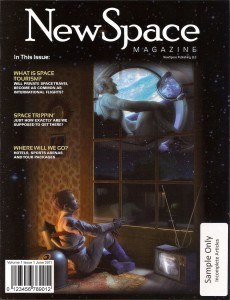Lost spaceby Dwayne A. Day
|
| There is a lot of uncertainty when combining the possibly failing magazine industry with the possibly rising NewSpace industry. |
The point is I read, a lot. I read just about everything that I can get my hands on, even stuff that I disagree with (sometimes, it even forces me to change my mind—shudder). So when I discovered that a new magazine was going to be published devoted to NewSpace and called, well, NewSpace, I decided to buy a copy as a prelude to subscribing. Alas, I recently got this message from the publisher:
With much regret, I’m writing to inform you that NewSpace Publishing, LLC will be unable to distribute the number of NewSpace Magazine’s June issue that I had hoped for. The magazine newsstand distribution I have been able to arrange falls short of what is financially feasible to justify printing.
When we began offering subscriptions a year ago, there was every indication that vehicles would be taking tourists into space by mid 2011. Unfortunately, it didn’t happen. As a result, there is not enough public interest in commercial spaceflight to provide a strong demand for NewSpace Magazine. This situation makes it necessary to temporarily shift NewSpace Magazine from a printed publication to a lower cost digital format.
When space tourism flights begin in mid to late 2012, I have no doubt these flights will attract a great deal of attention with the general public, and with that attention, create a demand for a printed edition of NewSpace Magazine.
This is actually the second magazine to attempt to cover the NewSpace field. Another magazine, Launch, folded in summer 2009. Launch was a slick glossy with beautiful layout and a focus on both NewSpace and amateur rocketry. It was carried by bookstores and newsstands. (See “Launch failure”, The Space Review, August 17, 2009.)
There is a lot of uncertainty when combining the possibly failing magazine industry with the possibly rising NewSpace industry. The magazine industry was already in trouble with the ascendancy of portable devices like the iPad (for which many publications do not yet have a business plan). Then Borders went into bankruptcy, instantly decimating newsstand sales of many magazines (as one of my editors bluntly put it: “If you want to see this magazine continue, subscribe!”). Digital is cheaper, but it comes with a lot of uncertainty. How does a new digital publication get visibility? A digital magazine should hopefully have better quality content than blogs and news sites, but how does it go about capturing eyeballs, especially for the readership that is not already interested in the subject?
| I hope that NewSpace succeeds, just as I hope that NewSpace succeeds. But I remain skeptical. |
Besides the uncertainty of the publishing industry, it is also clear that one of the things that hurt both of these publications is that NewSpace has failed to live up to the hype. Back in 2005 I made a bet with a NewSpace advocate that there would be no regular space tourism flights by 2008 (he picked 2007, but I gave him an extra year’s margin). I promptly forgot about the bet, but because he’s an honorable guy, he bought me a nice dinner three years later. Of course, that was three years ago and we’re still waiting. Now there’s talk that maybe we’ll have a paying flight sometime in 2012. Maybe. Trying to tie a magazine to a business that might or might not take off is a risk.
But, in fact, this is nothing new. During the last shuttle launch I was at the Kennedy Space Center Visitor’s Complex and picked up two impressive, high-quality, very glossy commemorative booklets for the launches of STS-134 and STS-135. They were aimed at the tourists who flocked to Cape Canaveral for the launch, but who probably don’t subscribe to a single space-related publication. During the 1980s and again in the 1990s there were several companies—usually little more than one person editing and writing, perhaps with a bit of unpaid help—that tried producing commemorative magazines to accompany shuttle launches. They were often essentially reprinted press releases and crew bios with NASA photos, and had variable quality. These publications all failed for the same reason that Launch failed and NewSpace is struggling. Back then, inconsistent shuttle launches made it impossible for the publishers to stay in business. Now, the fact that it has been seven years since the Ansari X Prize and nobody can yet reliably predict when space tourism is going to take off—or even that it will take off—makes it hard to get started.
I hope that NewSpace succeeds, just as I hope that NewSpace succeeds. But I remain skeptical. Always. And I’ll keep my piles of paper just in case I need that reading material on the desert isle.
